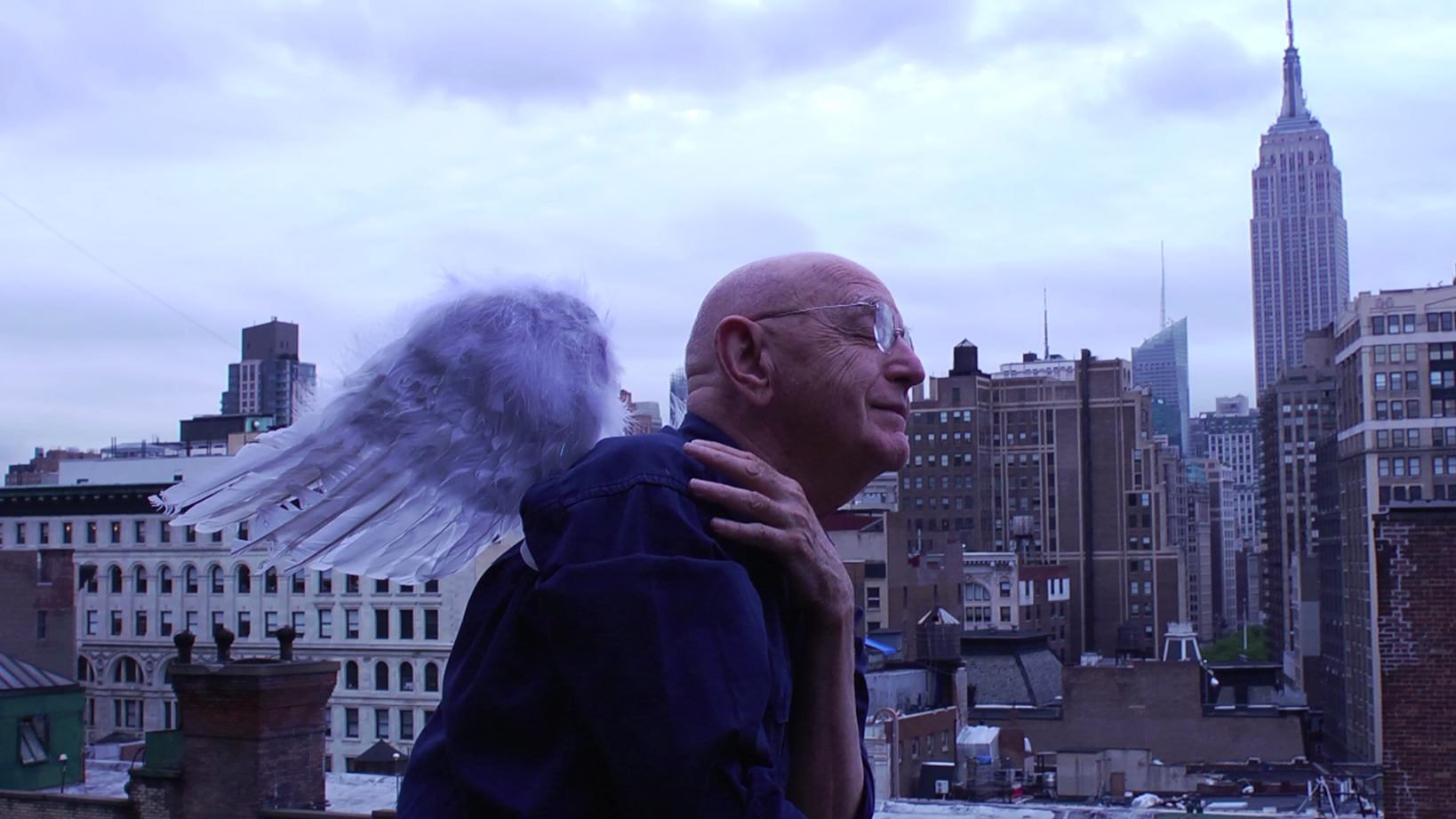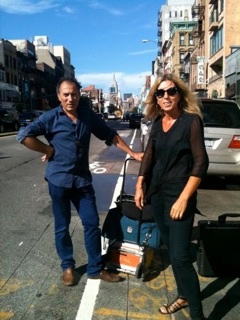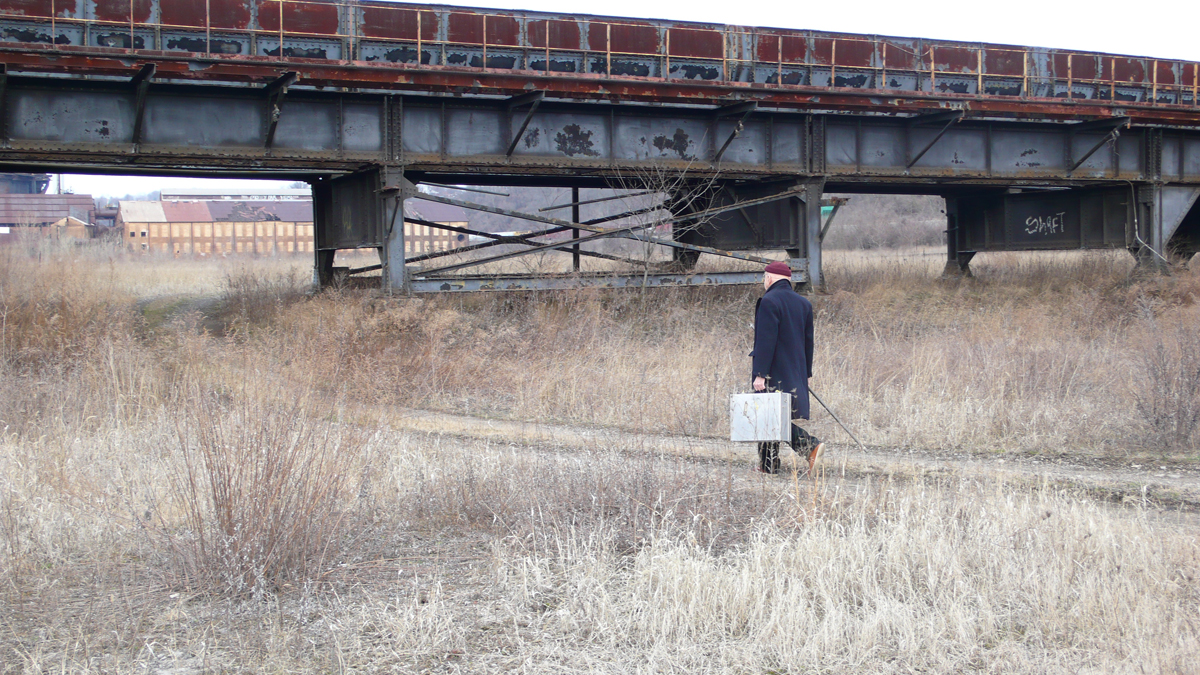I met Duane Michals when I was 24 years old. Throughout the years, he has been what I call my “spiritual advisor,” my role model in living life to the fullest. I was delighted to learn that the French producers (Terra Luna Films’ Anne Morien and France Saint Leger) of a new documentary about Michals’ life and work would be willing to let me post the trailer for the film on this blog; they, in turn, were happy about my plan to interview both Duane and New York co-producer Véronique Bernard. Morien and Saint Leger wrote a wonderful essay about the work-in-progress which was originally published in French for La Lettre de la Photographie (the Naudet brothers’ blog). Bernard has translated the text and I have edited it for an English speaking audience. Following this letter is the six minute trailer, a teaser for what is now a 90-minute documentary film (which is almost finished: the producers are currently fundraising to help defray post-production costs). As will be evident from the short clip, director Camille Guichard had a particular concept in mind while making this film. He wanted the documentary to bring forth emotions rather than historical facts. Instead of a predetermined biographical chronology, the work explores what he calls a “kaleidoscope of photographic sequences.” And then, finally, after the clip, as the pièce de resistance I’ve posted a short interview with Michals himself, who discusses what he has learned and what he has attempted to express in this latest creative endeavor.
SR
Do not awaken from your dreams, it’s too soon
Duane Michals
La Lettre de la Photographie – « Duane Michals 2012 »
by Anne Morien and France Saint Leger (translation by Véronique Bernard)
It was 2009 and we were headed to the South of France for the Rencontres d’Arles. A large Duane Michals retrospective was planned that year, and we were curious to rediscover his work that spanned half a century.
The exhibition was held at the Archevêché. The quality of the photographs selected for the show was clear, but there was a peculiar ambiance in the halls. The public was simply enraptured by Michals’ stories, his series, his words, his thoughts. Viewers of all ages were transfixed by the photographer’s poetic world. And we followed the wave of people, fascinated, amused, touched. Never has an exhibition caused so many laughs and mischievous looks. The visit concluded with Duane Michals himself moonwalking for the spectators. That night, at the ancient theatre, the house was packed and the day’s infatuation lingered. It wasn’t clear who was having more fun, Duane Michals or his audience. One thing was certain: we would have to make a film about him.
Right from the beginning, we wanted to make a film about Duane Michals’ inner world. We didn’t want just a portrait of the artist but something steeped in his stories that would allow people to discover him as a contemporary, talking Buster Keaton. His energy was incredible. He was always ready to explore new ideas, to take us into a world where humor and seriousness mingled effortlessly. To bring together all theses different elements and to harness this amazing energy, we chose director Camille Guichard whose sensibility, sense of humor and sensitivity seemed in tune with Duane Michals’ work.
The scouting trips to Pittsburgh and New York confirmed that. Duane and Camille immediately hit it off. Duane understood that the film was open to his imagination, that they would create it together. Once the locations were agreed on and Camille went back to Paris, the two of them were so excited about the project that they were on the phone constantly. Sequences were being dreamed up from one continent to the other. Duane kept offering ideas without worrying about the structure of the film. Camille embraced this way of working. It was up to him to make sense of the multitude of images Duane was proposing.
The first shoot in Pittsburgh was very emotional. Duane retraced the steps of his childhood, his relationship with his mother and with his father, a steel worker. There was no love lost between the couple. These were painful memories, but there were happy ones too. Months later, we were scouting again in New York City and Cambridge, Vermont where Duane owns a magnificent country house. This is where the film would explore the other themes close to Duane’s heart: sex, desire, time, death and homosexuality. The scenes started to take shape and other characters, friends of Duane, began to emerge. But it was important to stay within the film’s own reality, to keep it as a story, a game, a “mise-en-scène”. The film was beginning to have its own dreamlike quality, where documentary and fiction merged.
New York became the place where all these new encounters would take place. The invented scenes took shape, changing on Duane’s whim and Camille’s ideas. One day Duane’s shirt was wrong. No problem, Duane swapped shirts with the cameraman in the middle of the street. The next day, he did the same thing with Camille. There they were, bare-chested and laughing their heads off in the middle of Soho. And it worked. The new shirt turned Duane into the character invented for the scene. On another occasion, as the crew was shooting on a rooftop where Duane had photographed Joe d’Allesandro, Duane climbed up a ladder facing the Empire State Building to call out to New Yorkers. Suddenly he stopped. He needed angel wings like in the sequence of “Falling Angel.” He knew a store nearby. Camille agreed and off he went. As the crew waited for his return, the light was fading. They needed to hurry. Finally Duane arrived and climbed to the top of the ladder with the wings on his back. He put his hands around his mouth and started shouting” “Wake up New York!” It became the poster for the film.
Other anecdotes followed day after day. Then it was off to Cambridge, four hours north of New York City. The crew had a hard time keeping up with Duane who was driving so fast, as if he was in a hurry to get to the next part of the film. In the country, Camille spent time filming nature, Duane and his partner Fred. He wanted this part of the film to be in a different reality. He filmed Duane’s garden, flowers, the countryside around the house, trees, and stone walls. Duane suggested a scene where he talked with a stuffed duck. It would be his way of talking about the influence of painting on his photographic work. Then Duane wanted to take photos for an exhibition dedicated to animals, another sequence with a man plucking a star, and a scene about desire in an abandoned hotel. Duane resembled Méliès shooting in his studio. Duane’s ideas come and go like butterflies. You have to catch them. But if the butterfly gets away you have to let it go.
Duane Michals: The Man Who Invented Himself: a film coming soon. 90mn, HD, directed by Camille Guichard, produced by Anne Morien & France Saint Léger – Terra Luna Films in association with Veronique Bernard – Illiad Entertainment. Follow us on Facebook
Duane Michals: The Interview
By Shelley Rice, with Véronique Bernard
Shelley: So Duane, why did you want to do this film? Tell me the whole back story.
Duane: I hadn’t been in Arles for 25 years. They invited me to go and do a retrospective and a big presentation in 2009. It was a really wonderful evening, and the exhibit was very successful. But I started my presentation — in the center there is a spotlight and someone introduces you. Well, I moonwalked backwards onto the stage and it brought down the house. I just let fly, as you know I can do, and it got a huge response. You get such an international audience there. I had interviews from Finland, from Greece, from everywhere. The next day I ran into Anne and France and they asked me if I would like to do a movie, and I said sure. I never look a gift horse in the mouth. As you know, I’ve always taken advantage of every opportunity that came my way – otherwise I would still be sitting in dear old McKeesport!
Off the cuff, we had a lot of fun with this film, it was a nice feeling. I worked on another documentary about my life that was a scripted film, a serious chronology of dates and facts. This was more playful, we just made it up as we went along. One thing really got to me, though: after shooting and seeing myself on television for 13 days, I saw my strangeness. There’s a way we view ourselves. Before this, I didn’t really know how I sounded, I didn’t know my gestures. I couldn’t see my body language. I never saw THAT GUY – the ME that others see, and he’s strange. In making this film I came into my first recognition of my physical self as it might be viewed by somebody else. That moment when you recognize that other self, who may be the self that’s more real than you are, it’s a little bit startling. So that was interesting, to see all that. That, for me, was big.
The other interesting thing: The big danger for me, in making this film, was that we structured it starting from my childhood in McKeesport, Pennsylvania. Because I’m a narrative person, I saw the whole film as a story, a picturesque tale: Duane leaves McKeesport and his old house with a little suitcase and has a lot of adventures. I go to Pittsburgh, visit Russia, move to New York…and then in the end I literally die. My danger is that I had composed the film in my mind. But: it’s not my film.
Véronique: You learned that in filmmaking you don’t shoot in a logical order. It had a trajectory, but it was a different logic. The shooting was done using film logic, which is not the same as Duane’s. And since this is not a film with interviews, with people talking about Duane’s life and work, a lot of the story came together in the editing.
Shelley: Having starred in one of Duane’s sequences shot in Paris 20 years ago, I know what a tyrant he is when he works. So starring in someone else’s dream must have been a real shock for him!
Duane: In Camille’s version, editing was more like slice and dice, you take the pieces and arrange them and make a stew. My way would be…
Shelley: …to make a sequence!
Duane: …of no (con)sequence! (laughter) So understanding the structure of the movie was a big deal for me, and there were things I thought were important that didn’t make it in, since it’s not my film. BUT I want everyone to know that we did not use a body double. In all those nude scenes: that’s my real ass you see up there in all those pictures on screen. (laughter)
Véronique: The interesting thing for me, since I came into this later than the others, is to work with two creative people like Camille the director and Duane. They get along very well but they are different people, with different minds. All those non sequiturs that are part of the film, they are thematic instead of chronological. The film is told not like a logical narrative, but more like the way Duane thinks.
Duane: Well, I can’t avoid my process, I’ve spent 80 years honing it! The film has its own life and its own logic: Camille’s logic wedded to me as source material.
Véronique: You were more than source material! You created material specifically for the film.
Duane: It was exciting. And also, being 80, being on the cusp of oblivion, that’s where I am and so that’s what the film is about. First, my huge nostalgia for McKeesport, which I don’t really understand, is there. I still have the urge to go back, it’s like walking into a dream where all these places are still familiar but they don’t look the same, they are all falling down. It’s a bit like Miss Havisham, as if she herself were decorating McKeesport now. In one scene in the garden I imagined that she lived next door, and invented literary neighbors like Madame Bovary, who we called Emma and who hit on my dad… though the best part was telling how I saw the Eiffel Tower from a lighthouse tower. There’s a lot of whimsy in the film that’s not documentary at all. We told a lot of stories.
Véronique: But there is a sort of melancholy to the film, much talk about death and mortality and longing. There’s a lot of fun but an underlying seriousness.
Duane: I’m not a serious person but I am very serious; the serious trivia is underneath the other trivia.
Véronique: Deep down you are very superficial! (laughter) That’s an Ava Gardner quote, by the way.
Duane: The one overriding personal thing I learned from making this film, as I mentioned before, was the awareness of how I function as a physical object, as a creature in the real world in a way I never see. I find this knowledge rather startling, and upsetting, because it adds to my not knowing, not only my image of myself, or this conversation or this room, but the whole universe. We live in this bad joke, the universe is playing a bad joke on us by giving us consciousness and then letting us know that we’re going to die. At this point I’m beginning to face the fact that we spend our lives distracting ourselves from our own demise. Now I’m really facing the enigma and almost feel a little bit overwhelmed by it. Because there’s no help, and no exit. The only reference might be Buddhism; I might have to get back to sitting. It’s a very strange place to be. During these last years, where’s my attention, what do I do about it??
Véronique: But you do have the work you’ve created. How do you feel about your body of work?
Duane: Oh, I love my body of work, it’s really “built,” it’s got a great waist. (laughter). I am very happy with my body of work. I’ve done so much, I’m very prolific and I’ve done so many different things: a book on Egypt, a children’s book, books on Walt Whitman and Cavafy, on quantum physics, about being gay in the military, my childhood home etc. I have a huge body of work: it’s out there, I’ve done thirty-two books.
Véronique: And here you are now, making a film. That’s why the title is “The Man Who Invented Himself.” You do keep reinventing yourself all the time, that’s very apt.
Duane:
The Man Who Invented Himself
“All things that he experienced in this lifetime were his invention. He invented the moon and the trees and all things visible and invisible. At this moment he is inventing me writing this and you reading this. Yes, you too are his invention. But if you told him this he would not understand, he would deny it, even though all things he thought possible became possible, and all things he thought impossible were.
And in the end he would even invent his own death. And he would never know that he had invented it all.”
To me, that says everything. This possibility of invention doesn’t apply just to your writing or creative work but to the whole act of your life and the choices that you make. I think it’s a very interesting premise. That’s why I’m glad we used it in this film, and for the title.


